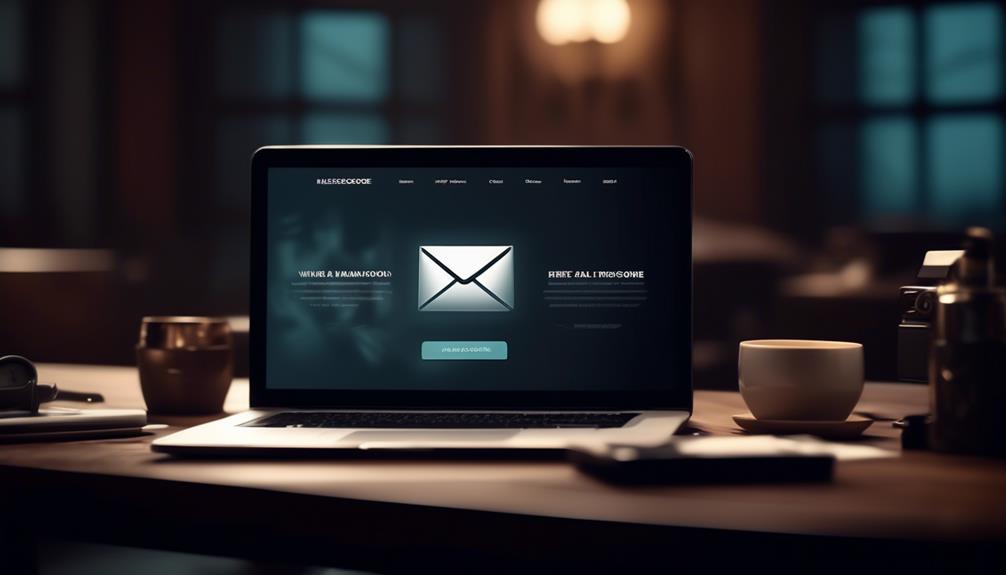Let’s delve into the functional possibilities of the Lightning Email Template Builder.
As businesses strive for efficiency and effectiveness in their email communications, the ability to craft compelling and customized templates becomes crucial.
But how does this tool empower users to streamline their email marketing efforts and elevate the impact of their messaging?
Stay tuned to uncover the strategic advantages and best practices associated with harnessing this innovative feature.
Key Takeaways
- Lightning Email Template Builder enables effortless creation of visually striking and personalized email templates.
- The drag-and-drop content builder makes customization easy and intuitive.
- Custom email templates save time and ensure a cohesive and professional representation of the brand.
- Integration with Salesforce Lightning enhances email communications and streamlines the process of creating and sending emails.
Enabling Lightning Email Template Builder
Enabling the Lightning Email Template Builder empowers us to effortlessly create visually striking and personalized email templates, enhancing the efficiency and impact of our email communications within Salesforce.
The ability to create Lightning Email templates using the drag-and-drop content builder and customize them with images, background colors, and components provides us with a powerful tool to elevate our email communications.
When we want to create a new email template, the Edit in Builder button allows us to seamlessly access the Lightning Email Template Builder, streamlining the template creation process.
To fully utilize the Lightning Email Template Builder, we must create a Permission Set that includes the Access drag-and-drop content builder permission. This ensures that we have the necessary permissions to make the most of the builder's capabilities.
Additionally, enabling Folders and Enhanced Sharing allows us to efficiently organize and share email templates within our Salesforce org, further enhancing collaboration and productivity.
Creating Custom Email Templates

Let's delve into the process of crafting personalized and impactful custom email templates in Salesforce Lightning. Using the Lightning Email Template Builder, users can create new and edit existing templates to align with their brand identity and communication needs. This powerful tool empowers users to design visually appealing templates that enhance efficiency and consistency in email communications. The drag-and-drop interface simplifies the process of adding images, adjusting layouts, and customizing content within email templates, making it easy to create professional and branded messages.
Creating custom email templates in Salesforce Lightning is an essential skill for mastering personalized and effective communication with clients and stakeholders. By leveraging the capabilities of the Lightning Email Template Builder, users can elevate their email communications to new heights. These custom email templates not only save time in crafting individual messages but also ensure a cohesive and professional representation of the brand in every interaction.
With the ability to create and edit Lightning Email Templates, users can confidently tailor their email communications for maximum impact and engagement.
Understanding the Limitations
Understanding the limitations of the Lightning Email Template Builder is essential for harnessing its full potential in crafting effective email communications. While the builder offers a user-friendly interface and convenient drag-and-drop content builder, there are certain constraints to consider:
- The inability to edit Classic email templates in the Content Builder can limit customization options and hinder seamless transition between the two email formats.
- Limited support for cross-object merge fields may restrict the level of personalization that can be achieved, potentially impacting the effectiveness of targeted communication.
- Missing functionality from Classic Templates in the Lightning Email Templates can impede the replication of certain features, potentially affecting the visual appeal and dynamic elements of the emails.
- The lack of support for Internet Explorer 11 may present accessibility challenges for users relying on this browser, potentially causing inconvenience and workflow disruptions.
Acknowledging these limitations empowers users to make informed decisions and explore workarounds to maximize the potential of the Lightning Email Template Builder. By understanding these constraints, users can effectively navigate the platform's capabilities and develop impactful email communications.
Integration With Salesforce Lightning

Integrating Lightning Email Templates with Salesforce Lightning offers a seamless and visually dynamic approach to enhancing email communications. By leveraging the Lightning Email Template Builder, users can create rich text and visually appealing email template details using the style and ease of drag-and-drop functionality.
To access the Lightning Email Templates, users can enable the feature in Salesforce Setup and utilize the Lightning App Launcher or the Quick Find Box to navigate to the templates. The integration with Salesforce Lightning enables the use of standard components to craft personalized emails efficiently.
Using the Lightning Email Builder Component, users can easily customize templates by dragging and dropping components and adjusting properties, providing a user-friendly and efficient way to enhance email communications.
This integration streamlines the process of creating and sending emails, ultimately boosting productivity and enabling a consistent brand experience across all communications.
Best Practices for Effective Email Marketing
Transitioning from integrating Lightning Email Templates with Salesforce Lightning, we now delve into the best practices for effective email marketing.
- Use a clear and concise subject line to capture the recipient's attention.
- Personalize emails with the recipient's name and relevant information.
- Optimize email content for mobile devices to ensure easy readability.
- Include a compelling call-to-action to encourage engagement.
When using Email Templates on the Salesforce platform, it's essential to keep these best practices in mind.
By editing the image width and ensuring compatibility across various browsers for the next level of user experience, the template name can be associated with successful email campaigns. Leveraging the image component within the new template can enhance engagement and drive results.
Frequently Asked Questions
How Do I Create a Lightning Email Template?
We create Lightning email templates by enabling them in Setup and customizing them through the App Launcher's Edit in Builder button.
The Lightning Email Builder Component allows us to drag-and-drop components and adjust their properties.
We then use these templates in Email Alerts or within Salesforce to avoid the default gray background.
Although Lightning Email Templates have limitations, such as the lack of support for cross-object merge fields, they're still a powerful tool for efficient communication.
What Is Difference Between Classic Email Template and Lightning Email Template?
In creating email templates, the difference between classic and lightning templates lies in their ease of use and customization options.
Lightning templates offer a more user-friendly interface and allow for easier customization and personalization. They enable the addition of images, buttons, and rich text components with greater ease compared to classic templates.
However, classic templates offer more flexibility in terms of merge fields and cross-object merge fields.
What Are the Limitations of Lightning Email Templates?
The limitations of lightning email templates include:
- The inability to edit them in Content Builder.
- Lack of support for cross-object merge fields.
- Missing functionality compared to Classic Templates.
Despite being less powerful than Email Studio, most activity-enabled objects resolve merge fields. However, these limitations might impact our email customization and personalization efforts. We'll need to explore workarounds and consider using Classic Templates in some cases.
What Are the 4 Types of Email Templates That Can Be Created in Salesforce?
We have four types of email templates in Salesforce:
- Standard Email Templates
- Custom HTML Email Templates
- Visualforce Email Templates
- Lightning Email Templates.
Each type offers varying levels of customization and functionality to suit different communication needs.
Standard templates are basic and non-customizable, while Lightning templates use a drag-and-drop interface for visually appealing and responsive designs.
Custom HTML and Visualforce templates provide extensive customization using HTML, CSS, and Visualforce markup.
Conclusion
In conclusion, the Lightning Email Template Builder in Salesforce has revolutionized the way we create email templates. Its user-friendly interface and customizable features have made the process efficient and effective.
With this tool, we can now create personalized, professional, and branded email templates in no time. It's a game-changer for our email marketing efforts and has truly elevated our communication with clients.
Try it out and see the difference for yourself!










